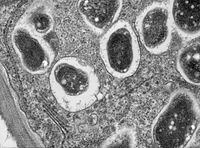
Photo from wikipedia
Plant growth-promoting rhizobacteria (PGPR) are widely used to improve soil nutrients and promote plant growth and health. However, the growth-promoting effect of a single PGPR on plants is limited. Here,… Click to show full abstract
Plant growth-promoting rhizobacteria (PGPR) are widely used to improve soil nutrients and promote plant growth and health. However, the growth-promoting effect of a single PGPR on plants is limited. Here, we evaluated the effect of applying rhizobium Bradyrhizobium japonicum 5038 (R5038) and two PGPR strains, Bacillus aryabhattai MB35-5 (BA) and Paenibacillus mucilaginosus 3016 (PM), alone or in different combinations on the soil properties and rhizosphere bacterial community composition of soybean (Glycine max). Additionally, metagenomic sequencing was performed to elucidate the profile of functional genes. Inoculation with compound microbial inoculant containing R5038 and BA (RB) significantly improved nodule nitrogenase activity and increased soil nitrogen content, and urease activity increased the abundance of the nitrogen cycle genes and Betaproteobacteria and Chitinophagia in the rhizosphere. In the treatment of inoculant-containing R5038 and PM (RP), significant changes were found for the abundance of Deltaproteobacteria and Gemmatimonadetes and the phosphorus cycle genes, and soil available phosphorus and phosphatase activity were increased. The RBP inoculants composed of three strains (R5038, BA and PM) significantly affected soybean biomass and the N and P contents of the rhizosphere. Compared with RB and RP, RBP consistently increased soybean nitrogen content, and dry weight. Overall, these results showed that several PGPR with different functions could be combined into composite bacterial inoculants, which coordinately modulate the rhizosphere microbial community structure and improve soybean growth.
Journal Title: Genes
Year Published: 2022
Link to full text (if available)
Share on Social Media: Sign Up to like & get
recommendations!